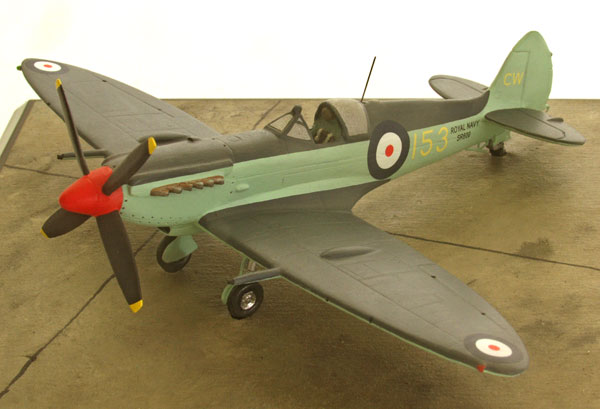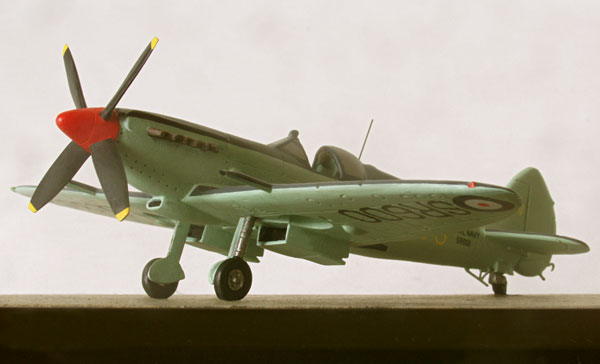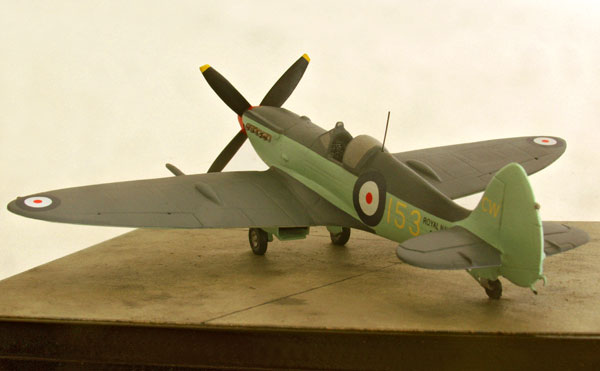Supermarine Seafire Mk XV
Supermarine Seafire Mk XV SR600 153/CW 790 Naval Air Station
Fighter Direction School, RNAS Culdrose, Early 1948.
The Seafires that served operationally with the Fleet Air Arm in the Second World war, involved in hostilities off Japan until the end were Merlin-powered; those with the bigger and more powerful Rolls-Royce Griffon were starting to come from the production lines of Westland and Cunliffe-Owen Aircraft in 1944, but were not introduced to front-line service until 1945.
It was the Seafire Mk XV that took the Griffon to sea. The navy had followed the original introduction of the Spitfire Mk XII, the first of the marque with the bigger engine, with interest and took two on charge to be flown by 778 NAS, the Fleet Air Arm’s Service Trials Unit. Following the problems with adaptation for naval service identified in the process, the Seafire Mk XV evolved based on the Seafire MK III airframe with the lengthened nose housing the Griffon and its four-bladed Rotol propeller, and a tail unit adapted from that of the Spitfire Mk VIII with a broader-chord rudder and a pointed tip. Six prototypes were built by Supermarine at their Hursley Park workshop, and production contracts were placed with Cunliffe-Owen Aircraft and Westland Aircraft, aircraft emerging from these factories in August 1944 and April 1945 respectively. The first fifty or so from Cunliffe-Owen had the “A-frame” arrester hooks of earlier Seafires but these were replaced by the “sting” hook, attached to and emerging from the lower section of the rudder. A retractable tailwheel was standard on Seafires from this mark onwards, and XVs had the folding wing with the tips also folding over to meet the Royal Navy’s hangar height requirement. Armament for the interceptor role, which was the type’s primary purpose, was a pair of 20 mm Hispano cannon and four 0.303 Browning machine guns. The last thirty of this mark from Westlands were completed with cut down rear fuselage, and a “bubble” canopy, which improved visibility; this foreshadowed the next variant, the XVII, which also added an improved main undercarriage with better responses for deck-landing.
The first front-line squadron to receive the Seafire Mk XV was 802 NAS, re-equipping in May 1945 and working up in and around Scotland; it carried out its first airfield-based practice deck landings on 1 July at Twatt in the Orkneys in preparation for operations in the Far East, and before the end of the month was at Abbotsinch ahead of embarkation. Its aircraft were loaded on to HMS Queen on 11 August, and were still in the Clyde when hostilities against Japan ceased. Mark XVs had left the front line (800-series) squadrons by the end of 1948, but served on with a couple of RNVR squadrons until 1951. Many also flew with 700-series second line squadrons in to the ‘fifties, one of these being 790 NAS, which having been established as a target-towing squadron in June 1941 was by 1946 flying aircraft for training for the Fighter Direction School, enabling its students to carry out live interceptions. It flew from several locations in South-West England, moving to Culdrose at the end of 1947, and flying the Seafire XV from May 1947 until January 1949. The unit was disbanded in November 1949.
SR600 was built by Westland Aircraft as part of the fifth contract for the mark, and taken on by the Royal Navy on 31 April, 1945. By the time it was serving with 790 NAS it had been repainted in the FAA’s post war camouflage of extra dark sea grey and sky, with red/white/blue roundels, but these were closer to the pre-war roundel proportions of 1/3/5 rather that those of 1/2/3 that were to become standard.
Scale 1:72 Wingspan 6.25″ (156 mm)
Base size 6.37″ (162 mm) square (No. 4)
Weight not including base 6.75 ozs (190 grams) Limited edition of 25 only




